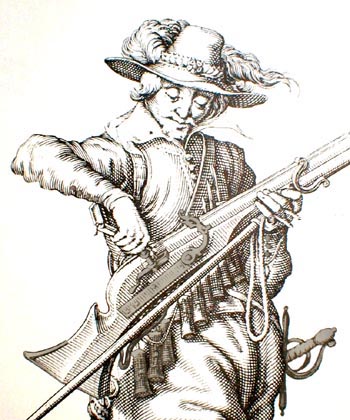In 1607 the graphic artist Jacob de Gheyn II published an illustrated military exercise manual entitled The Exercise of Armes. The publication reflected military reforms that took place in the Netherlands during the 1590s.
The publication highlights three groups of military exercises, which are portrayed in detailed engravings: the “musketeers,” shown here; “pikemen” (Pikeman); and the “shot” (a unit that carried a firearm called a caliver — not shown here).
Each group includes examples of men wearing the clothing and equipment generally thought of as appropriate for that type of unit. All the men in each unit would not have been equipped exactly alike, as they are in military units.
The men are depicted from different views revealing objects from different angles. The de Gheyn engravings are especially useful for help in the identification of badly corroded metal artifacts recovered from early-17th-century sites in Virginia.
For instance, in this image we see a Musketeer holding a matchlock musket, or arquebus as it was called in the 16th-century. From his shoulder hangs a bandolier — a strap with hanging containers, each holding a measured amount of powder. Note the “match” in his left hand, which would be clasped by the serpentine — the “snake head”–shaped arm on the lock plate.
Check out the glass buttons on his sleeves, the sword, the trigger guard, and the butt plate on the stock of the musket, the firing mechanism and bandolier cap.
To see another image from de Gheyn, visit our Pikeman webpage.
If you have questions or information about comparable artifacts from Virginia collections please contact Laura Galke, Chief Curator, State Archaeology Division or by phone at (804) 482-6441.
 Some of the shaded areas of this image show items similar to artifacts from DHR archaeological collections. Drag your cursor along the image to find items to click on to see similar artifacts in DHR Collections.
Some of the shaded areas of this image show items similar to artifacts from DHR archaeological collections. Drag your cursor along the image to find items to click on to see similar artifacts in DHR Collections.

